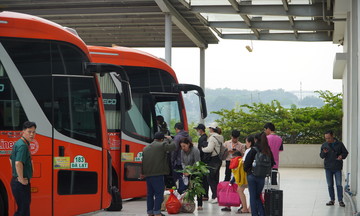The National Center for Hydro-Meteorological Forecasting reported that today marks the fourth consecutive day of widespread heat in northern Vietnam. In Hanoi, stations in Ha Dong, Ba Vi, Son Tay, and Hoai Duc also surpassed 39 degrees. In the southern part of the Red River Delta, the Phu Ly station (Ninh Binh) also recorded temperatures above 40 degrees Celsius.
Simultaneously, several other areas experienced intense heat, including Kim Boi, Chi Ne, Lac Son, and Vinh Yen (Phu Tho province); Hiep Hoa, Son Dong, and Bac Ninh City (Bac Ninh province); and Nam Dinh and Ninh Binh (Ninh Binh province). Most weather stations in northern Vietnam recorded temperatures between 36 and 38 degrees Celsius. These are temperatures measured inside weather shelters; the actual temperature felt is 2 to 4 degrees higher depending on the area, especially in places with concrete and asphalt surfaces.
 |
Hanoi residents endure the heat. Photo: Giang Huy |
Hanoi residents endure the heat. Photo: Giang Huy
Nguyen Van Huong, Head of the Weather Forecasting Department, explained that this record-breaking heat is due to the simultaneous impact of three atmospheric patterns. First, a strong western hot air mass pushed dry and hot air into northern Vietnam. Second, diverging wind patterns at altitudes of 1,500 to 3,000 meters from the north to northwest resulted in less cloud cover and prolonged sunshine, increasing radiation intensity. Third, westerly to southwesterly winds at lower altitudes blowing from Thanh Hoa downwards created a foehn wind effect, further drying the air and significantly reducing humidity.
At 1 PM today, humidity in Hanoi and the Red River Delta was only 47-52%, causing a noticeable dry and uncomfortable sensation.
Tonight, a low-pressure trough is forecast to bring thunderstorms to the midland and mountainous regions of northern Vietnam. Starting tomorrow afternoon and evening, thunderstorms will spread across the entire northern region, significantly lowering temperatures. The heat will only persist locally in the delta region, with temperatures around 35-36 degrees Celsius. By 6/8, with increased rainfall, the factors contributing to the heat, such as foehn winds, low hot air masses, and upper-level divergence, will cease, ending the widespread heatwave.
In July, northern Vietnam experienced three heat waves, from 8-9/7, 17-19/7, and 28-31/7, with temperatures 0.5 to 1.5 degrees Celsius higher than the multi-year average. In August, the heat is expected to be concentrated mainly in the first half of the month and then gradually decrease. The average temperature for the entire month is predicted to be approximately equal to the multi-year average.
Gia Chinh












